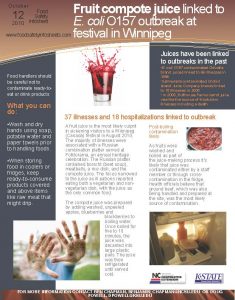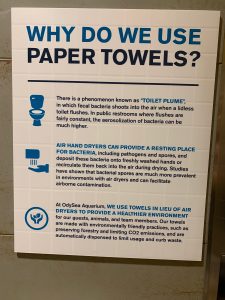More than 1.1 million people had already passed through the gates of the San Diego County Fair this summer by the time an E. coli outbreak forced the closure of all animal exhibits and rides.
 News that a 2-year-old boy had died after picking up the particularly nasty infection, which was also contracted by three other children with animal contact at the fair, stirred alarm within the community. Many had already roamed the midway, stuffed themselves full of fair food and passed through the venue’s cavernous livestock barns en route to pig races, pony rides and the petting zoo.
News that a 2-year-old boy had died after picking up the particularly nasty infection, which was also contracted by three other children with animal contact at the fair, stirred alarm within the community. Many had already roamed the midway, stuffed themselves full of fair food and passed through the venue’s cavernous livestock barns en route to pig races, pony rides and the petting zoo.
Paul Sisson of The San Diego Union Tribune reports hundreds of emails and other documents obtained through Public Records Act requests show that, while the public health team was able to move quickly, more frequent county case reviews, a more modern medical records system and more prompt and accurate responses from families with infected children might have gotten the investigation started days earlier.
The decision to shut down the animal exhibits on June 29, records show, came after four days of a behind-the-scenes scramble by the county’s public health department. With one death already on the books, they decided to notify the public even though testing had not yet confirmed that all four of those first four cases had E. coli infections.
It quickly became clear those initial instincts were accurate. In the following weeks, an additional seven people, plus two more whose infections weren’t confirmed, came forward, including another young boy who nearly died after suffering severe complications that attacked his kidneys.
Records show that zeroing in on the fairgrounds was no simple task. Epidemiologists had to eliminate a broad range of possible locations, from restaurants to a busy daycare center, before they were able to zero in on the fairgrounds.
 And there was plenty of other work that had to be done simultaneously. County records show that the department investigated 435 disease cases in June alone. Of those, there were 43 cases of shiga toxin-producing E. coli reported that month, forcing disease detectives to sift out the 11 eventually confirmed to be part of the outbreak.
And there was plenty of other work that had to be done simultaneously. County records show that the department investigated 435 disease cases in June alone. Of those, there were 43 cases of shiga toxin-producing E. coli reported that month, forcing disease detectives to sift out the 11 eventually confirmed to be part of the outbreak.
Determining whether there are connections between cases requires interviews with each subject or their legal guardians. Depending on the type of pathogen involved, it’s a process that often relies on frail human memory to recall the finest possible details of possible exposure routes from foreign travel and foods consumed to places visited and close contact with others.
The investigative process doesn’t get started until the health department is notified, usually after a test result administered in a doctor’s office or hospital comes back positive.
Subjects often aren’t interviewed until weeks after they got infected because many infections have incubation periods measured in days or weeks and it usually takes time before individuals decide to seek medical attention and additional time for medical providers to make a diagnosis.
Often, those charged with reading these particularly fragile tea leaves learn to trust their instincts, and that was certainly the case with the fairgrounds outbreak.
 Emails show that the county’s epidemiology team first began to suspect that it might have an outbreak on its hands on June 24, the day that 2-year-old Jedidiah King Cabezuela (right) was admitted to the intensive care unit at Rady Children’s Hospital with severe kidney problems.
Emails show that the county’s epidemiology team first began to suspect that it might have an outbreak on its hands on June 24, the day that 2-year-old Jedidiah King Cabezuela (right) was admitted to the intensive care unit at Rady Children’s Hospital with severe kidney problems.
While discussing his condition, an epidemiologist noted that the boy had visited the fair before he got sick. And, she said, the county had been notified just before Cabezuela’s death of another boy, this one 9 years old, who tested positive for the type of toxin produced by the E. coli strain causing so much difficulty for Cabezuela.
Though the 2-year-old and 9-year-old hadn’t eaten the same foods at the fair, and the older boy’s parents said he didn’t visit animal areas, the fact that both visited the same location was enough for the epidemiologist to suggest that the department “should at least keep an eye on” the 9-year-old, even though he never got sick enough to need hospitalization.
By Tuesday, June 25, the public health department received the news that Cabezuela died overnight, and that information pushed the team to begin a relentless search for similar shiga toxin-producing E. coli infections.
They quickly found a report of a 13-year-old girl who had a positive toxin test after visiting the fair on June 8. Her parents had told interviewers that she had contact with animals and had eaten fair food afterward without first washing her hands.
Another girl, this one age 11, had also had a positive test but her parents had not returned repeated calls for an interview. It would not become clear that she, too, had visited the fair and had contact with animals until her parents were finally reached on June 28, the same day that the county announced it would close all public animal exhibits.
Then there was the 9-year-old boy mentioned in that prescient June 24 email. His parents initially said that he had no animal contact at the fair, but in subsequent interviews those parents remembered that, yes, their son did visit the livestock barn when the family visited on June 13.
 With three, then four cases all reporting food consumption and animal contact at the fairgrounds, food inspectors descended on five different food vendors who sold items that the kids reported eating and found no traces of E. coli contamination.
With three, then four cases all reporting food consumption and animal contact at the fairgrounds, food inspectors descended on five different food vendors who sold items that the kids reported eating and found no traces of E. coli contamination.
Food poisoning ruled out, officials concluded that the E. coli exposure was most likely down to animals and, with the cooperation of the fair board, shut down all public access to animal exhibits and rides on June 29. Testing never did pinpoint the exact source of contamination, though the fair’s petting zoo and pony rides were ruled out.
Once public health nurses do their phone interviews and build up as clear a picture as they can of the circumstances surrounding each individual case, epidemiologists can begin looking for patterns, keeping an eye out for clusters of patients in specific geographic areas or with other commonalities such as foreign travel or consumption of tainted food.
A table of petting zoo outbreaks is available at https://www.barfblog.com/wp-content/uploads/2017/08/Petting-Zoo-Outbreaks-Table-7-26-17.xlsx
A timeline of the E. coli outbreak at the San Diego County Fair
May 31– San Diego County Fair opens
June 8 –11-year-old and 13-year-old girls visit fair
June 10 –13-year-old becomes ill
June 12 –11-year-old becomes ill after a second fair visit
June 13 – 9-year-old boy visits fair
June 15 – 2-year-old Jedidiah Cabezuela visits fair
June 16 – 9-year-old becomes ill
June 18 – Investigator call parents of 11-year-old, get no reply
June 19 – 13-year-old reports visiting animal areas at fair; Jedidiah becomes ill; county holds weekly analysis meeting
June 20 – Jedidiah admitted to Rady Children’s Hospital
June 21 – 4-year-old and 38-year-old who later test positive for E. coli infections visit fair
June 22 – Jedidiah diagnosed with severe E. coli infection; 6-year-old Ryan
Sadrabadi, 2-year-old Cristiano Lopez and his mother, Nicole Lopez, and another 2-year-old girl, visit the fair
June 23 – Family confirms Jedidiah visited fair’s animal exhibits; one-year-old girl later confirmed to have E. coli infection visits the fair
June 24 – Jedidiah dies from kidney failure; 9-year-old’s fair attendance confirmed, animal contact denied; County epidemiologist raises red flag about possible case cluster at fair; Nicole Lopez becomes ill, treated at Kaiser La Mesa
June 25 – County learns of Jedidiah’s death, begins exploring fair connections in depth
June 26 –Ryan, 2-year-old girl and 1-year-old become ill
June 28 – Family of 9-year-old revises statement, confirms visiting livestock barn; Family of 11-year-old confirms she visited sheep exhibit at fair; County announces E. coli cluster at Del Mar Fairgrounds; County inspects five food booths visited by first four cases, no E. coli found; Cristiano becomes ill
June 29 – County inspects all 160 food booths at fair, finds no E. coli contamination; All animal areas at the fair are closed; four-year-old becomes ill
June 30 – Ryan becomes ill diagnosed with E. coli infection
July 1 – 6-year-old’s case reported to county
July 2 – Cristiano admitted to Kaiser Permanente San Diego Medical Center with worsening symptoms, diagnosed with E. Coli infection
July 3 – 2-year-old girl and 4-year-old’s cases reported to county
July 4 – Fair closes with an attendance that exceeds 1.5 million; Cristiano’s infection reported to county; Cristiano transferred to Rady Children’s Hospital, undergoes dialysis for hemolytic uremic syndrome that attacks his kidneys
July 6 – 38-year-old becomes ill
July 9 – 38-year-old’s infection reported to county
July 10 – 30-year-old’s and 1-year-old’s infections reported to county
July 29 – Three families file claims against fair board, alleging they weren’t properly warned of E. coli risk
July 31 – Environmental and animal testing fail to reveal a clear source of outbreak, but exposure in fair’s livestock barn deemed “likely”
Best practices for planning events encouraging human-animal interactions
Zoonoses and Public Health
G. Erdozain , K. KuKanich , B. Chapman and D. Powell
http://onlinelibrary.wiley.com/doi/10.1111/zph.12117/abstract?deniedAccess
Educational events encouraging human–animal interaction include the risk of zoonotic disease transmission. It is estimated that 14% of all disease in the US caused by Campylobacter spp., Cryptosporidium spp., Shiga toxin-producing Escherichia coli (STEC) O157, non-O157 STECs, Listeria monocytogenes, nontyphoidal Salmonella enterica and Yersinia enterocolitica were attributable to animal contact. This article reviews best practices for organizing events where human–animal interactions are encouraged, with the objective of lowering the risk of zoonotic disease transmission.














